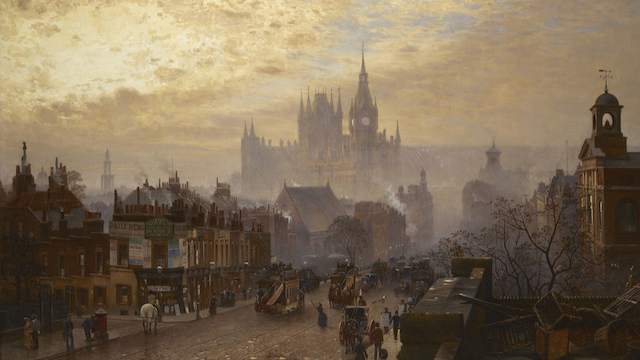
October 2, 1879: Holmes discovered the body of Brunton and identified the crown of Charles I. [MUSG]
A small chamber about seven feet deep and four feet square lay open to us. At one side of this was a squat, brass-bound wooden box, the lid of which was hinged upwards, with this curious old-fashioned key projecting from the lock. It was furred outside by a thick layer of dust, and damp and worms had eaten through the wood, so that a crop of livid fungi was growing on the inside of it. Several discs of metal, old coins apparently, such as I hold here, were scattered over the bottom of the box, but it contained nothing else.
At the moment, however, we had no thought for the old chest, for our eyes were riveted upon that which crouched beside it. It was the figure of a man, clad in a suit of black, who squatted down upon him hams with his forehead sunk upon the edge of the box and his two arms thrown out on each side of it. The attitude had drawn all the stagnant blood to the face, and no man could have recognised that distorted liver-coloured countenance; but his height, his dress, and his hair were all sufficient to show my client, when we had drawn the body up, that it was indeed his missing butler. He had been dead some days, but there was no wound or bruise upon his person to show how he had met his dreadful end. When his body had been carried from the cellar we found ourselves still confronted with a problem which was almost as formidable as that with which we had started.
October 2, 1900 (per Zeisler): Stapleton showed Watson and Sir Henry the site of the legend. [HOUN]

He came over to call upon Baskerville on that first day, and the very next morning he took us both to show us the spot where the legend of the wicked Hugo is supposed to have had its origin. It was an excursion of some miles across the moor to a place which is so dismal that it might have suggested the story. We found a short valley between rugged tors which led to an open, grassy space flecked over with the white cotton grass. In the middle of it rose two great stones, worn and sharpened at the upper end, until they looked like the huge corroding fangs of some monstrous beast.
In every way it corresponded with the scene of the old tragedy. Sir Henry was much interested and asked Stapleton more than once whether he did really believe in the possibility of the interference of the supernatural in the affairs of men. He spoke lightly, but it was evident that he was very much in earnest. Stapleton was guarded in his replies, but it was easy to see that he said less than he might, and that he would not express his whole opinion out of consideration for the feelings of the baronet. He told us of similar cases, where families had suffered from some evil influence, and he left us with the impression that he shared the popular view upon the matter.



 September 28, 1889: Hosmer Angel proposed that he and Mary Sutherland should marry within the next week. [IDEN]
September 28, 1889: Hosmer Angel proposed that he and Mary Sutherland should marry within the next week. [IDEN]




